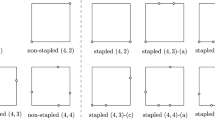Abstract
LetQ = {q1, q2,..., qn} be a set ofn points on the plane. The largest empty circle (LEG) problem consists in finding the largest circleC with center in the convex hull ofQ such that no pointq i εQ lies in the interior ofC. Shamos recently outlined anO(n logn) algorithm for solving this problem.(9) In this paper it is shown that this algorithm does not always work correctly. A different approach is proposed here and shown to also result in anO(n logn) algorithm. The new approach has the advantage that it can also solve more general problems. In particular, it is shown that if the center ofC is constrained to lie in an arbitrary convexn-gon, an0(n logn) algorithm can still be obtained. Finally, an0(n logn +k logn) algorithm is given for solving this problem when the center ofC is constrained to lie in an arbitrary simplen-gonP. wherek denotes the number of intersections occurring between edges ofP and edges of the Voronoi diagram ofQ andk ⩽O(n 2).
Similar content being viewed by others
References
J. L. Bentley and T. A. Ottmann, Algorithms for reporting and counting geometric intersections,IEEE Trans. Computers C-28:643–647 (September 1979).
B. M. Chazelle, Computational geometry and convexity, Ph.D. thesis, Carnegie-Mellon University (July 1980).
B. Chazelle and D. Dobkin, Detection is easier than computation, inACM Symposium on Theory of Computing, Los Angles, California, 146–153 (May 1980).
B. Dasarathy and L. J. White, On some maximum location and classifier problems, in Computer Science Conference, Washington, D.C. (1975) (unpublished lecture).
D. Kirkpatrick, Optimal search in planar subdivisions,SIAM J. Computing 12(1):28–35 (February 1983).
D. T. Lee and F. P. Preparata, Location of a point in a planar subdivision and its applications,SIAM J. Computing 8:542–545 (1979).
R. J. Lipton and R. E. Tarjan, Application of a planar separator theorem,SIAM J. Computing 9(3):615–627 (August 1980).
F. P. Preparata, A note on locating a set of points in a planar subdivision,SIAM J. Computing 8:542–545 (1979).
M. I. Shamos, Computational geometry, Ph.D. thesis, Yale University (1978).
M. I. Shamos,Problems in Computational Geometry, Carnegie-Mellon University (1977).
M. I. Shamos and D. Hoey, Closest-point problems, inSixteenth Annual IEEE Symposium on Foundations of Computer Science, pp. 151–162 (October 1975).
G. T. Toussaint and B. K. Bhattacharya, On geometric algorithms that use the furthest-point Voronoi diagram, Technical Report No. SOCS-81,3, School of Computer Science, McGill University (January 1981).
Author information
Authors and Affiliations
Additional information
Research suported by NSERC Grant No. A-9293 and FCAC Grant No. EQ-1678.
Technical Repot No. SOCS 83.4.
Rights and permissions
About this article
Cite this article
Toussaint, G.T. Computing largest empty circles with location constraints. International Journal of Computer and Information Sciences 12, 347–358 (1983). https://doi.org/10.1007/BF01008046
Received:
Revised:
Issue Date:
DOI: https://doi.org/10.1007/BF01008046




